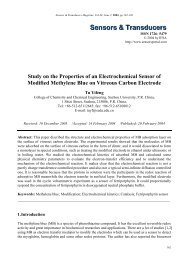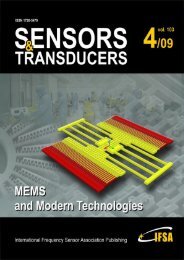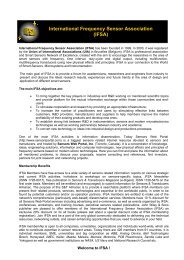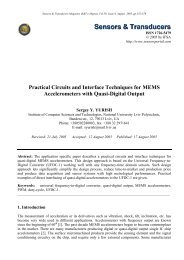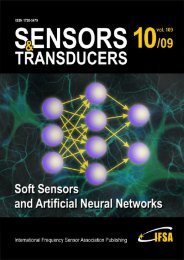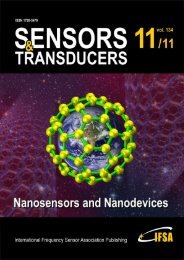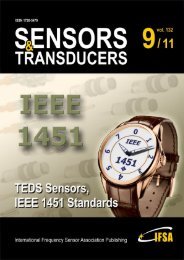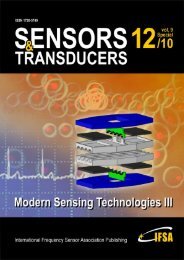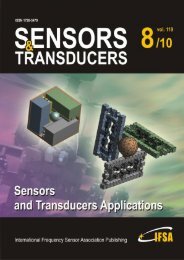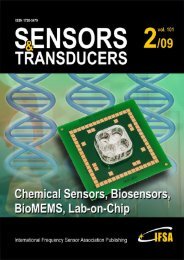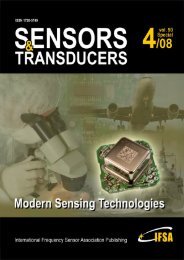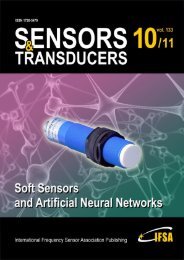TiO 2 Nanocomposite Ammonia Vapor Sensor - International ...
TiO 2 Nanocomposite Ammonia Vapor Sensor - International ...
TiO 2 Nanocomposite Ammonia Vapor Sensor - International ...
Create successful ePaper yourself
Turn your PDF publications into a flip-book with our unique Google optimized e-Paper software.
<strong>Sensor</strong>s & Transducers<br />
Volume 125, Issue 2,<br />
February 2011<br />
www.sensorsportal.com ISSN 1726-5479<br />
Editors-in-Chief: professor Sergey Y. Yurish, tel.: +34 696067716, fax: +34 93 4011989, e-mail: editor@sensorsportal.com<br />
Editors for Western Europe<br />
Meijer, Gerard C.M., Delft University of Technology, The Netherlands<br />
Ferrari, Vittorio, Universitá di Brescia, Italy<br />
Editor South America<br />
Costa-Felix, Rodrigo, Inmetro, Brazil<br />
Editor for Eastern Europe<br />
Sachenko, Anatoly, Ternopil State Economic University, Ukraine<br />
Editors for North America<br />
Datskos, Panos G., Oak Ridge National Laboratory, USA<br />
Fabien, J. Josse, Marquette University, USA<br />
Katz, Evgeny, Clarkson University, USA<br />
Editor for Asia<br />
Ohyama, Shinji, Tokyo Institute of Technology, Japan<br />
Editor for Asia-Pacific<br />
Mukhopadhyay, Subhas, Massey University, New Zealand<br />
Editorial Advisory Board<br />
Abdul Rahim, Ruzairi, Universiti Teknologi, Malaysia<br />
Ahmad, Mohd Noor, Nothern University of Engineering, Malaysia<br />
Annamalai, Karthigeyan, National Institute of Advanced Industrial Science<br />
and Technology, Japan<br />
Arcega, Francisco, University of Zaragoza, Spain<br />
Arguel, Philippe, CNRS, France<br />
Ahn, Jae-Pyoung, Korea Institute of Science and Technology, Korea<br />
Arndt, Michael, Robert Bosch GmbH, Germany<br />
Ascoli, Giorgio, George Mason University, USA<br />
Atalay, Selcuk, Inonu University, Turkey<br />
Atghiaee, Ahmad, University of Tehran, Iran<br />
Augutis, Vygantas, Kaunas University of Technology, Lithuania<br />
Avachit, Patil Lalchand, North Maharashtra University, India<br />
Ayesh, Aladdin, De Montfort University, UK<br />
Azamimi, Azian binti Abdullah, Universiti Malaysia Perlis, Malaysia<br />
Bahreyni, Behraad, University of Manitoba, Canada<br />
Baliga, Shankar, B., General Monitors Transnational, USA<br />
Baoxian, Ye, Zhengzhou University, China<br />
Barford, Lee, Agilent Laboratories, USA<br />
Barlingay, Ravindra, RF Arrays Systems, India<br />
Basu, Sukumar, Jadavpur University, India<br />
Beck, Stephen, University of Sheffield, UK<br />
Ben Bouzid, Sihem, Institut National de Recherche Scientifique, Tunisia<br />
Benachaiba, Chellali, Universitaire de Bechar, Algeria<br />
Binnie, T. David, Napier University, UK<br />
Bischoff, Gerlinde, Inst. Analytical Chemistry, Germany<br />
Bodas, Dhananjay, IMTEK, Germany<br />
Borges Carval, Nuno, Universidade de Aveiro, Portugal<br />
Bousbia-Salah, Mounir, University of Annaba, Algeria<br />
Bouvet, Marcel, CNRS – UPMC, France<br />
Brudzewski, Kazimierz, Warsaw University of Technology, Poland<br />
Cai, Chenxin, Nanjing Normal University, China<br />
Cai, Qingyun, Hunan University, China<br />
Campanella, Luigi, University La Sapienza, Italy<br />
Carvalho, Vitor, Minho University, Portugal<br />
Cecelja, Franjo, Brunel University, London, UK<br />
Cerda Belmonte, Judith, Imperial College London, UK<br />
Chakrabarty, Chandan Kumar, Universiti Tenaga Nasional, Malaysia<br />
Chakravorty, Dipankar, Association for the Cultivation of Science, India<br />
Changhai, Ru, Harbin Engineering University, China<br />
Chaudhari, Gajanan, Shri Shivaji Science College, India<br />
Chavali, Murthy, N.I. Center for Higher Education, (N.I. University), India<br />
Chen, Jiming, Zhejiang University, China<br />
Chen, Rongshun, National Tsing Hua University, Taiwan<br />
Cheng, Kuo-Sheng, National Cheng Kung University, Taiwan<br />
Chiang, Jeffrey (Cheng-Ta), Industrial Technol. Research Institute, Taiwan<br />
Chiriac, Horia, National Institute of Research and Development, Romania<br />
Chowdhuri, Arijit, University of Delhi, India<br />
Chung, Wen-Yaw, Chung Yuan Christian University, Taiwan<br />
Corres, Jesus, Universidad Publica de Navarra, Spain<br />
Cortes, Camilo A., Universidad Nacional de Colombia, Colombia<br />
Courtois, Christian, Universite de Valenciennes, France<br />
Cusano, Andrea, University of Sannio, Italy<br />
D'Amico, Arnaldo, Università di Tor Vergata, Italy<br />
De Stefano, Luca, Institute for Microelectronics and Microsystem, Italy<br />
Deshmukh, Kiran, Shri Shivaji Mahavidyalaya, Barshi, India<br />
Dickert, Franz L., Vienna University, Austria<br />
Dieguez, Angel, University of Barcelona, Spain<br />
Dimitropoulos, Panos, University of Thessaly, Greece<br />
Ding, Jianning, Jiangsu Polytechnic University, China<br />
Djordjevich, Alexandar, City University of Hong Kong, Hong Kong<br />
Donato, Nicola, University of Messina, Italy<br />
Donato, Patricio, Universidad de Mar del Plata, Argentina<br />
Dong, Feng, Tianjin University, China<br />
Drljaca, Predrag, Instersema <strong>Sensor</strong>ic SA, Switzerland<br />
Dubey, Venketesh, Bournemouth University, UK<br />
Enderle, Stefan, Univ.of Ulm and KTB Mechatronics GmbH, Germany<br />
Erdem, Gursan K. Arzum, Ege University, Turkey<br />
Erkmen, Aydan M., Middle East Technical University, Turkey<br />
Estelle, Patrice, Insa Rennes, France<br />
Estrada, Horacio, University of North Carolina, USA<br />
Faiz, Adil, INSA Lyon, France<br />
Fericean, Sorin, Balluff GmbH, Germany<br />
Fernandes, Joana M., University of Porto, Portugal<br />
Francioso, Luca, CNR-IMM Institute for Microelectronics and Microsystems, Italy<br />
Francis, Laurent, University Catholique de Louvain, Belgium<br />
Fu, Weiling, South-Western Hospital, Chongqing, China<br />
Gaura, Elena, Coventry University, UK<br />
Geng, Yanfeng, China University of Petroleum, China<br />
Gole, James, Georgia Institute of Technology, USA<br />
Gong, Hao, National University of Singapore, Singapore<br />
Gonzalez de la Rosa, Juan Jose, University of Cadiz, Spain<br />
Granel, Annette, Goteborg University, Sweden<br />
Graff, Mason, The University of Texas at Arlington, USA<br />
Guan, Shan, Eastman Kodak, USA<br />
Guillet, Bruno, University of Caen, France<br />
Guo, Zhen, New Jersey Institute of Technology, USA<br />
Gupta, Narendra Kumar, Napier University, UK<br />
Hadjiloucas, Sillas, The University of Reading, UK<br />
Haider, Mohammad R., Sonoma State University, USA<br />
Hashsham, Syed, Michigan State University, USA<br />
Hasni, Abdelhafid, Bechar University, Algeria<br />
Hernandez, Alvaro, University of Alcala, Spain<br />
Hernandez, Wilmar, Universidad Politecnica de Madrid, Spain<br />
Homentcovschi, Dorel, SUNY Binghamton, USA<br />
Horstman, Tom, U.S. Automation Group, LLC, USA<br />
Hsiai, Tzung (John), University of Southern California, USA<br />
Huang, Jeng-Sheng, Chung Yuan Christian University, Taiwan<br />
Huang, Star, National Tsing Hua University, Taiwan<br />
Huang, Wei, PSG Design Center, USA<br />
Hui, David, University of New Orleans, USA<br />
Jaffrezic-Renault, Nicole, Ecole Centrale de Lyon, France<br />
Jaime Calvo-Galleg, Jaime, Universidad de Salamanca, Spain<br />
James, Daniel, Griffith University, Australia<br />
Janting, Jakob, DELTA Danish Electronics, Denmark<br />
Jiang, Liudi, University of Southampton, UK<br />
Jiang, Wei, University of Virginia, USA<br />
Jiao, Zheng, Shanghai University, China<br />
John, Joachim, IMEC, Belgium<br />
Kalach, Andrew, Voronezh Institute of Ministry of Interior, Russia<br />
Kang, Moonho, Sunmoon University, Korea South<br />
Kaniusas, Eugenijus, Vienna University of Technology, Austria<br />
Katake, Anup, Texas A&M University, USA<br />
Kausel, Wilfried, University of Music, Vienna, Austria<br />
Kavasoglu, Nese, Mugla University, Turkey<br />
Ke, Cathy, Tyndall National Institute, Ireland<br />
Khelfaoui, Rachid, Université de Bechar, Algeria<br />
Khan, Asif, Aligarh Muslim University, Aligarh, India<br />
Kim, Min Young, Kyungpook National University, Korea South<br />
Ko, Sang Choon, Electronics. and Telecom. Research Inst., Korea South<br />
Kockar, Hakan, Balikesir University, Turkey<br />
Kong, Ing, RMIT University, Australia<br />
Kotulska, Malgorzata, Wroclaw University of Technology, Poland<br />
Kratz, Henrik, Uppsala University, Sweden
Kumar, Arun, University of South Florida, USA<br />
Kumar, Subodh, National Physical Laboratory, India<br />
Kung, Chih-Hsien, Chang-Jung Christian University, Taiwan<br />
Lacnjevac, Caslav, University of Belgrade, Serbia<br />
Lay-Ekuakille, Aime, University of Lecce, Italy<br />
Lee, Jang Myung, Pusan National University, Korea South<br />
Lee, Jun Su, Amkor Technology, Inc. South Korea<br />
Lei, Hua, National Starch and Chemical Company, USA<br />
Li, Genxi, Nanjing University, China<br />
Li, Hui, Shanghai Jiaotong University, China<br />
Li, Xian-Fang, Central South University, China<br />
Liang, Yuanchang, University of Washington, USA<br />
Liawruangrath, Saisunee, Chiang Mai University, Thailand<br />
Liew, Kim Meow, City University of Hong Kong, Hong Kong<br />
Lin, Hermann, National Kaohsiung University, Taiwan<br />
Lin, Paul, Cleveland State University, USA<br />
Linderholm, Pontus, EPFL - Microsystems Laboratory, Switzerland<br />
Liu, Aihua, University of Oklahoma, USA<br />
Liu Changgeng, Louisiana State University, USA<br />
Liu, Cheng-Hsien, National Tsing Hua University, Taiwan<br />
Liu, Songqin, Southeast University, China<br />
Lodeiro, Carlos, University of Vigo, Spain<br />
Lorenzo, Maria Encarnacio, Universidad Autonoma de Madrid, Spain<br />
Lukaszewicz, Jerzy Pawel, Nicholas Copernicus University, Poland<br />
Ma, Zhanfang, Northeast Normal University, China<br />
Majstorovic, Vidosav, University of Belgrade, Serbia<br />
Marquez, Alfredo, Centro de Investigacion en Materiales Avanzados, Mexico<br />
Matay, Ladislav, Slovak Academy of Sciences, Slovakia<br />
Mathur, Prafull, National Physical Laboratory, India<br />
Maurya, D.K., Institute of Materials Research and Engineering, Singapore<br />
Mekid, Samir, University of Manchester, UK<br />
Melnyk, Ivan, Photon Control Inc., Canada<br />
Mendes, Paulo, University of Minho, Portugal<br />
Mennell, Julie, Northumbria University, UK<br />
Mi, Bin, Boston Scientific Corporation, USA<br />
Minas, Graca, University of Minho, Portugal<br />
Moghavvemi, Mahmoud, University of Malaya, Malaysia<br />
Mohammadi, Mohammad-Reza, University of Cambridge, UK<br />
Molina Flores, Esteban, Benemérita Universidad Autónoma de Puebla,<br />
Mexico<br />
Moradi, Majid, University of Kerman, Iran<br />
Morello, Rosario, University "Mediterranea" of Reggio Calabria, Italy<br />
Mounir, Ben Ali, University of Sousse, Tunisia<br />
Mulla, Imtiaz Sirajuddin, National Chemical Laboratory, Pune, India<br />
Nabok, Aleksey, Sheffield Hallam University, UK<br />
Neelamegam, Periasamy, Sastra Deemed University, India<br />
Neshkova, Milka, Bulgarian Academy of Sciences, Bulgaria<br />
Oberhammer, Joachim, Royal Institute of Technology, Sweden<br />
Ould Lahoucine, Cherif, University of Guelma, Algeria<br />
Pamidighanta, Sayanu, Bharat Electronics Limited (BEL), India<br />
Pan, Jisheng, Institute of Materials Research & Engineering, Singapore<br />
Park, Joon-Shik, Korea Electronics Technology Institute, Korea South<br />
Penza, Michele, ENEA C.R., Italy<br />
Pereira, Jose Miguel, Instituto Politecnico de Setebal, Portugal<br />
Petsev, Dimiter, University of New Mexico, USA<br />
Pogacnik, Lea, University of Ljubljana, Slovenia<br />
Post, Michael, National Research Council, Canada<br />
Prance, Robert, University of Sussex, UK<br />
Prasad, Ambika, Gulbarga University, India<br />
Prateepasen, Asa, Kingmoungut's University of Technology, Thailand<br />
Pullini, Daniele, Centro Ricerche FIAT, Italy<br />
Pumera, Martin, National Institute for Materials Science, Japan<br />
Radhakrishnan, S. National Chemical Laboratory, Pune, India<br />
Rajanna, K., Indian Institute of Science, India<br />
Ramadan, Qasem, Institute of Microelectronics, Singapore<br />
Rao, Basuthkar, Tata Inst. of Fundamental Research, India<br />
Raoof, Kosai, Joseph Fourier University of Grenoble, France<br />
Reig, Candid, University of Valencia, Spain<br />
Restivo, Maria Teresa, University of Porto, Portugal<br />
Robert, Michel, University Henri Poincare, France<br />
Rezazadeh, Ghader, Urmia University, Iran<br />
Royo, Santiago, Universitat Politecnica de Catalunya, Spain<br />
Rodriguez, Angel, Universidad Politecnica de Cataluna, Spain<br />
Rothberg, Steve, Loughborough University, UK<br />
Sadana, Ajit, University of Mississippi, USA<br />
Sadeghian Marnani, Hamed, TU Delft, The Netherlands<br />
Sandacci, Serghei, <strong>Sensor</strong> Technology Ltd., UK<br />
Schneider, John K., Ultra-Scan Corporation, USA<br />
Sengupta, Deepak, Advance Bio-Photonics, India<br />
Shah, Kriyang, La Trobe University, Australia<br />
Sapozhnikova, Ksenia, D.I.Mendeleyev Institute for Metrology, Russia<br />
Saxena, Vibha, Bhbha Atomic Research Centre, Mumbai, India<br />
Seif, Selemani, Alabama A & M University, USA<br />
Seifter, Achim, Los Alamos National Laboratory, USA<br />
Silva Girao, Pedro, Technical University of Lisbon, Portugal<br />
Singh, V. R., National Physical Laboratory, India<br />
Slomovitz, Daniel, UTE, Uruguay<br />
Smith, Martin, Open University, UK<br />
Soleymanpour, Ahmad, Damghan Basic Science University, Iran<br />
Somani, Prakash R., Centre for Materials for Electronics Technol., India<br />
Srinivas, Talabattula, Indian Institute of Science, Bangalore, India<br />
Srivastava, Arvind K., NanoSonix Inc., USA<br />
Stefan-van Staden, Raluca-Ioana, University of Pretoria, South Africa<br />
Sumriddetchka, Sarun, National Electronics and Computer Technology Center,<br />
Thailand<br />
Sun, Chengliang, Polytechnic University, Hong-Kong<br />
Sun, Dongming, Jilin University, China<br />
Sun, Junhua, Beijing University of Aeronautics and Astronautics, China<br />
Sun, Zhiqiang, Central South University, China<br />
Suri, C. Raman, Institute of Microbial Technology, India<br />
Sysoev, Victor, Saratov State Technical University, Russia<br />
Szewczyk, Roman, Industrial Research Inst. for Automation and Measurement,<br />
Poland<br />
Tan, Ooi Kiang, Nanyang Technological University, Singapore,<br />
Tang, Dianping, Southwest University, China<br />
Tang, Jaw-Luen, National Chung Cheng University, Taiwan<br />
Teker, Kasif, Frostburg State University, USA<br />
Thirunavukkarasu, I., Manipal University Karnataka, India<br />
Thumbavanam Pad, Kartik, Carnegie Mellon University, USA<br />
Tian, Gui Yun, University of Newcastle, UK<br />
Tsiantos, Vassilios, Technological Educational Institute of Kaval, Greece<br />
Tsigara, Anna, National Hellenic Research Foundation, Greece<br />
Twomey, Karen, University College Cork, Ireland<br />
Valente, Antonio, University, Vila Real, - U.T.A.D., Portugal<br />
Vanga, Raghav Rao, Summit Technology Services, Inc., USA<br />
Vaseashta, Ashok, Marshall University, USA<br />
Vazquez, Carmen, Carlos III University in Madrid, Spain<br />
Vieira, Manuela, Instituto Superior de Engenharia de Lisboa, Portugal<br />
Vigna, Benedetto, STMicroelectronics, Italy<br />
Vrba, Radimir, Brno University of Technology, Czech Republic<br />
Wandelt, Barbara, Technical University of Lodz, Poland<br />
Wang, Jiangping, Xi'an Shiyou University, China<br />
Wang, Kedong, Beihang University, China<br />
Wang, Liang, Pacific Northwest National Laboratory, USA<br />
Wang, Mi, University of Leeds, UK<br />
Wang, Shinn-Fwu, Ching Yun University, Taiwan<br />
Wang, Wei-Chih, University of Washington, USA<br />
Wang, Wensheng, University of Pennsylvania, USA<br />
Watson, Steven, Center for NanoSpace Technologies Inc., USA<br />
Weiping, Yan, Dalian University of Technology, China<br />
Wells, Stephen, Southern Company Services, USA<br />
Wolkenberg, Andrzej, Institute of Electron Technology, Poland<br />
Woods, R. Clive, Louisiana State University, USA<br />
Wu, DerHo, National Pingtung Univ. of Science and Technology, Taiwan<br />
Wu, Zhaoyang, Hunan University, China<br />
Xiu Tao, Ge, Chuzhou University, China<br />
Xu, Lisheng, The Chinese University of Hong Kong, Hong Kong<br />
Xu, Sen, Drexel University, USA<br />
Xu, Tao, University of California, Irvine, USA<br />
Yang, Dongfang, National Research Council, Canada<br />
Yang, Shuang-Hua, Loughborough University, UK<br />
Yang, Wuqiang, The University of Manchester, UK<br />
Yang, Xiaoling, University of Georgia, Athens, GA, USA<br />
Yaping Dan, Harvard University, USA<br />
Ymeti, Aurel, University of Twente, Netherland<br />
Yong Zhao, Northeastern University, China<br />
Yu, Haihu, Wuhan University of Technology, China<br />
Yuan, Yong, Massey University, New Zealand<br />
Yufera Garcia, Alberto, Seville University, Spain<br />
Zakaria, Zulkarnay, University Malaysia Perlis, Malaysia<br />
Zagnoni, Michele, University of Southampton, UK<br />
Zamani, Cyrus, Universitat de Barcelona, Spain<br />
Zeni, Luigi, Second University of Naples, Italy<br />
Zhang, Minglong, Shanghai University, China<br />
Zhang, Qintao, University of California at Berkeley, USA<br />
Zhang, Weiping, Shanghai Jiao Tong University, China<br />
Zhang, Wenming, Shanghai Jiao Tong University, China<br />
Zhang, Xueji, World Precision Instruments, Inc., USA<br />
Zhong, Haoxiang, Henan Normal University, China<br />
Zhu, Qing, Fujifilm Dimatix, Inc., USA<br />
Zorzano, Luis, Universidad de La Rioja, Spain<br />
Zourob, Mohammed, University of Cambridge, UK<br />
<strong>Sensor</strong>s & Transducers Journal (ISSN 1726-5479) is a peer review international journal published monthly online by <strong>International</strong> Frequency <strong>Sensor</strong> Association (IFSA).<br />
Available in electronic and on CD. Copyright © 2011 by <strong>International</strong> Frequency <strong>Sensor</strong> Association. All rights reserved.
<strong>Sensor</strong>s & Transducers Journal<br />
Contents<br />
Volume 125<br />
Issue 2<br />
February 2011<br />
www.sensorsportal.com ISSN 1726-5479<br />
Research Articles<br />
Microcantilever <strong>Sensor</strong>s in Biological and Chemical Detections<br />
Qing Zhu............................................................................................................................................. 1<br />
Design of a Low Voltage 0.18 um CMOS Surface Acoustic Wave Gas <strong>Sensor</strong><br />
M. Moghavvemi and A. Attaran .......................................................................................................... 22<br />
Glucose Monitoring System Based on Osmotic Pressure Measurements<br />
Alexandra Leal, António Valente, Ana Ferreira, Salviano Soares, Vitor Ribeiro, Olga<br />
Krushinitskaya, and Erik A. Johannessen .......................................................................................... 30<br />
Chemical <strong>Vapor</strong> Identification by Plasma Treated Thick Film Tin Oxide Gas <strong>Sensor</strong> Array<br />
and Pattern Recognition<br />
J. K. Srivastava, Preeti Pandey, Sunil K. Jha, V. N. Mishra, R. Dwivedi ........................................... 42<br />
A Preliminary Test for Skin Gas Assessment Using a Porphyrin Based Evanescent Wave<br />
Optical Fiber <strong>Sensor</strong><br />
Roman Selyanchyn, Sergiy Korposh, Wataru Yasukochi and Seung-Woo Lee. ............................... 54<br />
Optical Characterization and Humidity Sensing Properties of Praseodymium Oxide<br />
B. C. Yadav, Monika Singh and C. D. Dwivedi................................................................................... 68<br />
Nanocrystalline SnO 2 -Pt Thick Film Gas <strong>Sensor</strong> for Air Pollution Applications<br />
M. H. Shahrokh Abadi, M. N. Hamidon, Abdul Halim Shaari, Norhafizah Abdullah,<br />
Rahman Wagiran and Norhisam Misron. ........................................................................................... 76<br />
Characterization of WO 3 -SnO 2 <strong>Nanocomposite</strong>s and Application in Humidity Sensing<br />
N. K. Pandey, Akash Roy, Alok Kumar. ............................................................................................. 89<br />
Detections of Water Content Changes in a Nitrocellulose Membrane Based on Polarized<br />
Reflection Spectroscopy<br />
Hariyadi Soetedjo ............................................................................................................................... 100<br />
Fabrication of Polyaniline/ <strong>TiO</strong> 2 <strong>Nanocomposite</strong> <strong>Ammonia</strong> <strong>Vapor</strong> <strong>Sensor</strong><br />
S. G. Pawar, S. L. Patil, M. A. Chougule, B. T. Raut, S. A.Pawar and V. B. Patil ............................. 107<br />
Impact of Mineral Composition on the Distribution of Natural Radionuclides in Rigosol-<br />
Anthrosol<br />
Z P. Tomić, A. R. Djordjević, M. B. Rajković, I. Vukašinović, N. S. Nikolić, V. Pavlović<br />
and Č. M. Lačnjevac........................................................................................................................... 115<br />
Design of Photoreactor and Study of Modeling Parameters for Removal of Pesticides in<br />
Water: a Case Study of Malathion<br />
Amit K. Sharma, R. K. Tiwari and M. S. Gaur .................................................................................... 131<br />
Studies on Gas Sensing Performance of Cr-doped Indium Oxide Thick Film <strong>Sensor</strong>s<br />
D. N. Chavan, G. E. Patil, D. D. Kajale, V. B. Gaikwad, G. H. Jain ................................................... 142<br />
Preparation and Studies on Gas Sensing Performance of Pure and Modified Sn-<strong>TiO</strong> 2 Thick<br />
Film Resistor<br />
P. D. Hire, V. B. Gaikwad, N. U. Patil, R. L. Patil, R. M. Chaudhri, S. D. Shinde G. H. Jain ............. 156<br />
Electrocoductivity Studies of Grafted Polymer Thin Film 168
Muhammed Mizher Radhi ..................................................................................................................<br />
Ester Sensing with Poly (Aniline-co-m-aminobenzoic Acid) Deposited on Poly (Vinyl<br />
Alcohol)<br />
S. Adhikari, J. Singh, R. Banerjee and P. Banerji .............................................................................. 177<br />
Fiber Bragg Grating <strong>Sensor</strong> for Detection of Nitrate Concentration in Water<br />
A. S. Lalasangi, J. F. Akki, K.G. Manohar, T. Srinivas, P. Radhakrishnan, Sanjay Kher,<br />
N. S. Mehla and U. S. Raikar ............................................................................................................. 187<br />
Study on Gas Sensing Performance of In 2 O 3 Thick Film Resistors Prepared by Screen<br />
Printing Technique<br />
S. C. Kulkarni, R. Y. Borse ................................................................................................................. 194<br />
Periodically Tapered LPFG for Ethanol Concentration Detection in Ethanol-Gasoline Blend<br />
J. Linesh, T. M. Libish, M. C. Bobby, P. Radhakrishnan and V. P. N. Nampoori............................... 205<br />
Chemically Deposited n-CuInSe 2 / Polyiodide Based PEC Solar Cells<br />
R. H. Bari and L. A. Patil..................................................................................................................... 213<br />
Sensitivity and Selectivity Studies on Polyaniline / Molybdenum Trioxide Composites to<br />
Liquid Petroleum Gas<br />
Aashis S. Roy, Machappa T, M. V. N. Ambika Prasad and Koppalkar R. Anilkumar ........................ 220<br />
Long-term Biosensors for Metabolite Monitoring by using Carbon Nanotubes<br />
Cristina Boero, Sandro Carrara, Giovanni De Micheli........................................................................ 229<br />
Modeling of a Bio <strong>Sensor</strong> Based on Detection of Antigens Concentration Using an<br />
Electrically Actuated Micro Cantilever<br />
Hadi Madinei, Ali-Asghar Keyvani-Janbahan, Mehdi Atashparva, Rasool Shabani,<br />
Ghader Rezazadeh ............................................................................................................................ 238<br />
A SAW Delay Line <strong>Sensor</strong> Combined with Micro-hotplate for Bio-chemical Applications<br />
Babak Vosoughi Lahijani, Habib Badri Ghavifekr............................................................................... 247<br />
Bioelectrical Impedance Analysis Device: Measurement of Bioelectrical Tissue<br />
Conductivity in Dengue Patients<br />
Herlina Abdul Rahim, Mohd Nasir Taib, Fatimah Ibrahim and Ruzairi Abdul Rahim......................... 256<br />
Authors are encouraged to submit article in MS Word (doc) and Acrobat (pdf) formats by e-mail: editor@sensorsportal.com<br />
Please visit journal’s webpage with preparation instructions: http://www.sensorsportal.com/HTML/DIGEST/Submition.htm<br />
<strong>International</strong> Frequency <strong>Sensor</strong> Association (IFSA).
<strong>Sensor</strong>s & Transducers Journal, Vol. 125, Issue 2, February 2011, pp. 107-114<br />
<strong>Sensor</strong>s & Transducers<br />
ISSN 1726-5479<br />
© 2011 by IFSA<br />
http://www.sensorsportal.com<br />
Fabrication of Polyaniline/ <strong>TiO</strong> 2 <strong>Nanocomposite</strong><br />
<strong>Ammonia</strong> <strong>Vapor</strong> <strong>Sensor</strong><br />
S. G. Pawar, S. L. Patil, M. A. Chougule, B. T. Raut, S. A. Pawar and * V. B. Patil<br />
Materials Research Laboratory, School of physical Sciences, Solapur University,<br />
Solapur (MS), India<br />
Tel.: +912172744771, fax: +912172744770<br />
E-mail: drvbpatil@gmail.com<br />
Received: 23 November 2010 /Accepted: 15 February 2011 /Published: 28 February 2011<br />
Abstract: Polyaniline/Titanium dioxide (PANi/<strong>TiO</strong> 2 ) nanocomposite was fabricated from PANi,<br />
prepared by oxidative chemical polymerization and <strong>TiO</strong> 2 , synthesized by sol gel method. The<br />
PANi/<strong>TiO</strong> 2 thin film sensors were prepared by spin coating technique. PANi/<strong>TiO</strong> 2 nanocomposites<br />
were characterized by XRD and SEM. The cross sensitivity of thin film sensor indicate that the sensor<br />
exhibit selectivity to ammonia (NH 3 ). The gas sensing measurements were carried out for different<br />
concentrations of NH 3 . The gas sensing study revealed that the response value increases with<br />
increasing concentration of NH 3 . Moreover, as concentration of NH 3 increases, the response time<br />
decreases while recovery time increases, which can be attributed to the varying adsorption and<br />
desorption rates of an ambient gas with increasing concentration. Copyright © 2011 IFSA.<br />
Keywords: PANi/<strong>TiO</strong> 2 nanocomposite, Response, Selectivity, Response time, Recovery time.<br />
1. Introduction<br />
In recent years, the demand for gas sensors for safety control requirements and environmental<br />
monitoring has expanded enormously. Choice of suitable sensing material along with efficient<br />
microelectronics for the detection system is the key step in such efforts [1]. The use of conducting<br />
polymers as sensing elements in chemical sensors is attracting attention due to their high sensitivity in<br />
change of the electrical and optical properties when exposed to different types of gases or liquids. The<br />
ease in synthesis of these polymers and sensitivity at room temperature add to the sensor’s advantages.<br />
This can be of importance particularly as ammonia sensors that are used in different applications such<br />
as industrial process, fertilizers, food technology, clinical diagnosis, farms and environmental pollution<br />
107
<strong>Sensor</strong>s & Transducers Journal, Vol. 125, Issue 2, February 2011, pp. 107-114<br />
monitoring [2]. Polyaniline is one of the most attractive materials among the variety of conducting<br />
polymers due to its unique electrical properties, environmental stability, easy fabrication process and<br />
intrinsic redox reaction [3-5]. Polyaniline has also been used in different applications such as light<br />
emitting diodes [6], rechargeable batteries [7] and photovoltaic cells [8]. However, the problems with<br />
these conducting polymers are their low processing ability, poor chemical stability and mechanical<br />
strength [9]. There is a tremendous approach for the enhancement of the mechanical strength and<br />
characteristics of sensors by combining the organic materials with inorganic counterparts to form<br />
composites [10, 11]. Accordingly, organic inorganic nanocomposite sensors have been developed by<br />
several research groups. Dhawale et al [12] fabricated polyaniline titanium dioxide heterostructure gas<br />
sensor for LPG sensing, Tai et al [13] fabricated a polyaniline titanium dioxide nanocomposite for NH 3<br />
and CO sensors and reported that the resistance of the composite increased with increasing<br />
concentration of the gases. The PANi/SnO 2 hybrid material was prepared by a hydrothermal method<br />
and studied for gas sensing of ethanol and acetone by L. Geng et al [14]. Parvatikar et al [15]<br />
fabricated polyaniline/WO 3 composite based sensor and reported that the film conductivity increased<br />
with increasing humidity. Among the inorganic materials, nanocrystalline <strong>TiO</strong> 2 is one of the most<br />
attractive and extensively used materials for detection of H 2 , LPG, NO 2 and NH 3 gases [12].<br />
In the present paper, we report fabrication of polyaniline/ <strong>TiO</strong> 2 nanocomposite thin film gas sensors<br />
working at room temperature. The cross sensitivity of the sensor to various gases indicate the<br />
selectivity of the sensor to ammonia. The nanocomposites were characterized by X-ray diffraction<br />
(XRD) in 2θ range of 10–70 o using X-ray Diffractometer (Model: Philips PW3710). Morphological<br />
study of PANi/<strong>TiO</strong> 2 (0 – 50 wt %) composite films was carried out using scanning electron microscopy<br />
(SEM Model: JEOL JSM 6360) operating at 20 kV. The gas sensing measurements were made using<br />
gas sensor set up at room temperature.<br />
2. Experimental<br />
2.1. Fabrication of PANi/<strong>TiO</strong> 2 <strong>Nanocomposite</strong> <strong>Sensor</strong> Films<br />
The <strong>TiO</strong> 2 nanocomposites with PANi were prepared by adding <strong>TiO</strong> 2 in different weight percentage<br />
(0 - 50 weight %) in smooth agate mortar and pestle. The nanocomposite powder was put in m-cresol<br />
and stirred for 11 hrs to get casting solution. Thin films were prepared on glass substrates by spin<br />
coating method at 3000 rpm for 40 s and dried on hot plate at 100 0 C for 10 min [16]. The silver paste<br />
strips of 1 mm wide and 1 cm apart from each other were made on films for contacts.<br />
3. Results and Discussion<br />
3.1. X- ray Diffraction Studies<br />
Fig. 1 denotes X-ray diffraction patterns of the PANi, <strong>TiO</strong> 2 and PANi/<strong>TiO</strong> 2 nanocomposites<br />
(20-50 wt %) materials. The XRD pattern of PANi (Fig. 1a) shows a broad peak at 2θ= 25.30˚ which<br />
corresponds to (110) plane of PANi [17]. The diffraction pattern of <strong>TiO</strong> 2 (Fig. 1b) show sharp and well<br />
defined peaks, indicate the crystallinity of synthesized material. The intensities of diffraction peaks for<br />
PANi/<strong>TiO</strong> 2 nanocomposites (Fig. 1 c) are lower than that for <strong>TiO</strong> 2 . The presence of amorphous PANi<br />
reduces the mass volume percentage of <strong>TiO</strong> 2 and sequentially weakens diffraction peaks of <strong>TiO</strong> 2 . It has<br />
also been observed that the crystallinity of PANi is improved by the addition of <strong>TiO</strong> 2 nanoparticles.<br />
XRD diffractograms of PANi/<strong>TiO</strong> 2 nanocomposites have shown that all major diffraction peaks of<br />
nanocrystalline <strong>TiO</strong> 2 and are in the same peak angle positions. The observed 2θ values are consistent<br />
with the standard JCPDS values (JCPDS No. 78-1285 & 86) which enumerate the mixed anatase and<br />
rutile tetragonal structure of <strong>TiO</strong> 2 .<br />
108
<strong>Sensor</strong>s & Transducers Journal, Vol. 125, Issue 2, February 2011, pp. 107-114<br />
(a)<br />
Pure PANi<br />
(b)<br />
101 A<br />
<strong>TiO</strong>2<br />
Intensity (a.u)<br />
Intensity (a.u)<br />
101 R<br />
111 R<br />
004 A<br />
200 A<br />
105 A<br />
211 A<br />
204 A<br />
116 A<br />
220 A<br />
215A<br />
110<br />
10 20 30 40 50 60 70<br />
2 (degree)<br />
20 30 40 50 60 70 80<br />
2 (degree)<br />
(a)<br />
(b)<br />
(c)<br />
101 A<br />
PANi:<strong>TiO</strong> 2<br />
Intensity (a.u.)<br />
50 %<br />
40 %<br />
110 PANi<br />
004 A<br />
112 A<br />
105 A<br />
211 A<br />
204 A<br />
116 A<br />
30 %<br />
20 %<br />
10 20 30 40 50 60 70<br />
2 q (degree)<br />
(c)<br />
Fig. 1. X ray diffraction patterns of a) Pure PANi b) <strong>TiO</strong> 2 and C) PANi/<strong>TiO</strong> 2 (0 - 50 wt %).<br />
3.2. Scanning Electron Microscopy<br />
Fig. 2 a, b and c shows the scanning electron micrographs of PANi, <strong>TiO</strong> 2 and PANi/<strong>TiO</strong> 2 (50 wt %)<br />
films at x 20,000 magnification, respectively. The SEM image of the polyaniline film (Fig. 2a) exhibits<br />
a fibrous structure with many pores and gaps among the fibers. Fig. 2b shows the surface morphology<br />
of the <strong>TiO</strong> 2 nanoparticles film, annealed at 700˚C for 1 h. The image shows that the nanoparticles are<br />
fine with an average grain size of about 60 nm. The image of the nanocomposite (Fig. 2c) shows that<br />
there is no agglomeration and uniform distribution of the <strong>TiO</strong> 2 particles in the PANi matrix. It was<br />
considered that the nanostructured <strong>TiO</strong> 2 particles embedded within the netlike structure built by PANi<br />
chains.<br />
The morphology plays an important role in sensitivity of the gas sensing films. The grain sizes,<br />
structural formation, surface to volume ratio and film thickness are important parameters for gas<br />
sensing films. It can be seen that the PANi and PANi/<strong>TiO</strong> 2 films have a very porous structure,<br />
interconnected network of fibers and high surface area. It has also been pointed out that such structure<br />
contributes to a rapid diffusion of dopants into the film.<br />
109
<strong>Sensor</strong>s & Transducers Journal, Vol. 125, Issue 2, February 2011, pp. 107-114<br />
(a)<br />
(b)<br />
(c)<br />
Fig. 2. Scanning electron micrographs of a) PANi; b) <strong>TiO</strong> 2 and c) PANi/<strong>TiO</strong> 2 (50 wt %) films.<br />
3.3. Gas Sensing Measurements<br />
In order to record response to different gases, contacts were made on the silver paste strips, 1mm wide<br />
and 1cm apart from each other. The films deposited on the glass substrates were mounted in an airtight<br />
SS housing of 250 cc and measured quantity of desired gas (from a standard canister of 1000 ppm<br />
concentration) was injected through syringe so as to yield desired gas concentration in the housing.<br />
The room temperature gas response to various concentrations of different oxidizing and reducing<br />
(ammonia, ethanol, methanol, nitrogen dioxide and hydrogen sulfide) gases were measured by<br />
recording the resistance of the film in air and in presence of any particular ambient. A Rigol 3062<br />
(6 ½ digit) DMM was used to measure the resistance variation of the sensor films. The sensor response<br />
(S) was defined as S = (Rg – Ra)/Ra, where Rg and Ra are the resistance of sensor film in a measuring<br />
gas and in clean air respectively [13]. The gas sensing measurement set up used is as shown in Fig. 3.<br />
An attempt was made to study selectivity of PANi/<strong>TiO</strong> 2 films for lower concentration of NH 3 (20 ppm)<br />
as compared to the sensitivities for higher concentration of CH 3 -OH, C 2 H 5 -OH, NO 2 and H 2 S<br />
(100 ppm). The bar chart for selectivity is as shown in Fig. 4. It is observed that PANi/<strong>TiO</strong> 2 thin films<br />
can sense lower concentration of NH 3 with higher sensitivity value as compared to large concentration<br />
of other gases. The plausible mechanism of selectivity for NH 3 may be traced to the characteristics of<br />
vapor adsorbed over the surface of PANi/<strong>TiO</strong> 2 nanocomposite.<br />
110
<strong>Sensor</strong>s & Transducers Journal, Vol. 125, Issue 2, February 2011, pp. 107-114<br />
Fig. 3. Gas sensing measurement set up.<br />
20 pp m PANi/ Ti O2<br />
10<br />
8<br />
Response %<br />
6<br />
4<br />
2<br />
0<br />
100 pp m<br />
100 pp m 100 pp m 100 pp m<br />
NH3 CH3-OH C2H5-OH NO2 H2S<br />
Gas<br />
Fig. 4. Gas responses of PANi/<strong>TiO</strong> 2 sensor film to 20 ppm of NH 3 and 100 ppm<br />
of CH 3 -OH, C 2 H 5 -OH, NO 2 and H 2 S.<br />
Therefore the sensing capability of PANi/<strong>TiO</strong> 2 (50 wt %) nanocomposite sensor towards different<br />
concentrations (20 -100 ppm) of ammonia vapour has been explored and compared with the results<br />
obtained for PANi sensor film. Fig. 5 (a) shows electrical response of PANi to 100 ppm of NH 3 and<br />
Fig. 5 (b) of PANi/<strong>TiO</strong> 2 to 20, 40, 60, 80 and 100 ppm of NH 3 . As seen for both the sensor films, the<br />
resistance increases dramatically upon exposure to ammonia vapor, attains stable value and decreases<br />
gradually after being transferred to clean air.<br />
Moreover, the nanocomposite sensor exhibit high response to ammonia than pure PANi sensor. The<br />
increase in resistance after exposure to NH 3 may be because of porous structure of PANi/<strong>TiO</strong> 2 films<br />
leads to the predominance of surface phenomena over bulk material phenomena, which may again be<br />
111
<strong>Sensor</strong>s & Transducers Journal, Vol. 125, Issue 2, February 2011, pp. 107-114<br />
due to surface adsorption effect, and chemisorptions leads to the formation of ammonium. The<br />
resistance attains stable value when dynamic equilibrium is attained [19]. In order to explain the higher<br />
response and gas sensing mechanism of PANi/<strong>TiO</strong> 2 nanocomposite H. Tai et al [13] postulated that<br />
PANi and <strong>TiO</strong> 2 may form a p-n junction and the observed increased response of the nanocomposite<br />
material may be due to the creation of positively charged depletion layer on the surface of <strong>TiO</strong> 2 which<br />
could be formed owing to inter –particle electron migration from <strong>TiO</strong> 2 to PANi at the heterojunction.<br />
This would cause the reduction of the activation energy and enthalpy of physisorption for NH 3 gas.<br />
(a)<br />
Gas out<br />
2.2<br />
PANi<br />
100ppm NH3<br />
2.6<br />
2.4<br />
(b) PANi:<strong>TiO</strong> 2<br />
100ppm<br />
80ppm<br />
60ppm<br />
40ppm<br />
20ppm<br />
Resistance (x10 6 )/ <br />
2.1<br />
2.0<br />
1.9<br />
Resistance (x10 5 )/ <br />
2.2<br />
2.0<br />
1.8<br />
1.8<br />
Gas in<br />
0 100 200 300 400 500 600<br />
Time/ s<br />
1.6<br />
100 200 300 400 500 600 700<br />
Time/ s<br />
(a)<br />
(b)<br />
Fig. 5. Gas responses of PANi/<strong>TiO</strong> 2 sensor film to 20 ppm of NH 3 and 100 ppm<br />
of CH 3 -OH, C 2 H 5 -OH, NO 2 and H 2 S.<br />
The response values of PANi/<strong>TiO</strong> 2 sensor film is plotted as a function of NH 3 concentration in Fig. 6. It<br />
is observed that the response slows down at higher concentration; this may be due to less availability<br />
of surface area with possible reaction sites on surface of the film.<br />
50 PANi: <strong>TiO</strong> 2<br />
45<br />
40<br />
35<br />
Response%<br />
30<br />
25<br />
20<br />
15<br />
10<br />
20 40 60 80 100<br />
NH 3<br />
ppm<br />
Fig. 6. Response of PANi/<strong>TiO</strong> 2 thin film sensor to NH 3 (20- 100 ppm).<br />
112
<strong>Sensor</strong>s & Transducers Journal, Vol. 125, Issue 2, February 2011, pp. 107-114<br />
The response/recovery time is an important parameter use for characterizing a sensor. The response<br />
time and recovery time are defined as the times of 90% total resistance change [12]. Fig. 7 shows the<br />
response and recovery times of PANi/<strong>TiO</strong> 2 for different concentrations of NH 3 . It is revealed that the<br />
response time decreases from 72 s to 41 s, when NH 3 concentration increased from 20 ppm<br />
to 100 ppm, this may be because of high surface area due to porous structure of exposed film which<br />
facilitates rapid diffusion of gas molecules into the film. From the same graph, it is found that for<br />
higher concentration of NH 3 , the recovery time was long. This may probably due to lower desorption<br />
rate and reaction products are not leaving from the interface immediately after the reaction.<br />
Response time /s<br />
74<br />
72<br />
70<br />
68<br />
66<br />
64<br />
62<br />
60<br />
58<br />
56<br />
54<br />
52<br />
50<br />
48<br />
46<br />
44<br />
42<br />
40<br />
38<br />
Response<br />
Recovery<br />
20 40 60 80 100<br />
NH 3<br />
Conc./ ppm<br />
540<br />
520<br />
500<br />
480<br />
460<br />
440<br />
420<br />
400<br />
380<br />
360<br />
340<br />
Recovery time /s<br />
Fig. 7. Variation of response and recovery time of the PANi/<strong>TiO</strong> 2 thin film sensor<br />
with NH 3 concentration.<br />
4. Conclusions<br />
The PANi/<strong>TiO</strong> 2 thin film sensor was fabricated by spin coating technique. The composites have poorer<br />
crystallinity than <strong>TiO</strong> 2 , because of amorphous structure of PANi. But crystallinity of nanocomposites<br />
has been improved with increasing percentage of <strong>TiO</strong> 2 nanoparticles. It can be seen that PANi/<strong>TiO</strong> 2<br />
film has a very porous structure, interconnected network of fibers and high surface area, which<br />
contributes to a rapid diffusion of dopants into the film. The cross sensitivity of thin film sensor<br />
indicate that the sensor exhibit selectivity to ammonia (NH 3 ). The gas sensing measurements were<br />
carried out for different concentrations of NH 3 at room temperature. It is observed that the response<br />
slows down at higher concentration; this may be due less availability of surface area with possible<br />
reaction sites on surface of the film. Moreover, as concentration of NH 3 increases, the response time<br />
decreases while recovery time increases, which can be attributed to the varying adsorption and<br />
desorption rates of an ambient gas with increasing concentration.<br />
Acknowledgements<br />
Authors (VBP) are grateful to the Department of Science and Technology, New Delhi for financial<br />
support through the scheme no. SR/FTP/PS-09/2007. Thanks are also extended to Dr. Rashinkar,<br />
Department of Chemistry, SUK for FTIR facility, Prof. Lonikar, School of chemical Sciences, SUS for<br />
UV facility and Dr. P. S. Patil, Department of Physics, Shivaji University, Kolhapur for providing<br />
SEM facility.<br />
113
<strong>Sensor</strong>s & Transducers Journal, Vol. 125, Issue 2, February 2011, pp. 107-114<br />
References<br />
[1]. G. K. Prasad, T. P. Radhakrishnan, D. Sravan Kumar, M. Ghanshyam Krishna, <strong>Ammonia</strong> sensing<br />
characteristics of thin film based on polyelectrolyte template polyaniline, Sens. Actuat. B, 106, 2005,<br />
pp. 626-631.<br />
[2]. C. Wrenn, Real time measurement of ammonia gas, Occu. Health Saf., 69b, 2000, pp. 64-67.<br />
[3]. R. L. N. Chandrakanthi, M. A. Careem, Preparation and characterization of CdS and Cu 2 S<br />
nanoparticle/polyaniline composite films, Thin Solid Films, 417, 2002, pp. 51-56.<br />
[4]. P. R. Somani, R. Marimuthu, U. P. Mulik, S. R. Mulik, S. R. Sanikar, D. P. Amalnerkar, High<br />
piezorestivity and its origin in conducting polyaniline/<strong>TiO</strong> 2 composites, Synth. Met., 106, 1999, pp. 45-52.<br />
[5]. Y. He, Synthesis of polyaniline/nano-CeO 2 composite microspheres via a solid – stabilized emulsion route,<br />
Mater. Chem. Phys., 92, 2005, pp. 134-137.<br />
[6]. S. A. Chen, K. R. Chuang, C. I. Chao, H. T. Lee, White light emission from electroluminescence diode<br />
with polyaniline as the emitting layer, Synth. Met., 82, 1996, pp. 207-210.<br />
[7]. A. G. MacDiarmid, L. S. Yang, W. S. Huang, B. D. Humphrey, Polyaniline: electrochemistry and<br />
application to rechargeable batteries, Synth Met., 18, 1987, pp. 393-398.<br />
[8]. D. Verma, V. Datta, Role of novel microstructure of polyaniline-CSA thin film in ammonia sensing at<br />
room temperature, Sens. Actuat. B, 134, 2008, pp. 373-376.<br />
[9]. M. Mastuguchi, A. Okamoto, Y, Sakai, Effect of humidity on NH 3 gas sensitivity of polyaniline blend<br />
films, Sens. Actuators B, 94, 2003, pp. 46-42.<br />
[10]. F. Y. Chaung, S. M Yang, Titanium oxidepolyaniline core-shell nanocomposites, Synth. Met., 152, 2005,<br />
pp. 361-364.<br />
[11]. A. Z. Sadek, W. Wlodarski, K. Shin, R. Bkaner, K. Kalantar-zadeh, A layered surface acoustic wave gas<br />
sensor based on a polyaniline/ In 2 O 3 nanofibre composite, Nanotechnology, 17, 2006, pp. 4488-4492.<br />
[12]. D. S. Dhawale, R. R. Salunkhe, U. M. Patil, K. V. Gurav, A. M. More, C. D. Lokhande, Room temperature<br />
liquefied petroleum gas (LPG) sensor based on p-polyaniline/n-<strong>TiO</strong> 2 heterojunction, Sens. Actuat. B, 134,<br />
2008, pp. 988-992.<br />
[13]. H. Tai, Y. Juang, G. Xie, J. Yu, X. Chen, Fabrication and gas sensitivity of polyaniline- titanium dioxide<br />
nanocomposite thin film, Sens. Actuators B, 125, 2007, pp. 664-650.<br />
[14]. L. Geng, Y. Zhao, X. Huang, S. Wang, S. Zhang, S. Wu, Characterization and gas sensitivity study of<br />
polyaniline/SnO2 hybrid material prepared by hydrothermal route, Sens. Actuators B, 120, 2007,<br />
pp. 568-572.<br />
[15]. N. Parvatikar, S. Jain, S. Khasim, M. Ravansiddappa, S. V. Bhoraskar, M. V. N. Ambikaprasad, Electrical<br />
and humidity sensing properties of polyaniline/WO 3 composites, Thin Solid Films, 514, 2006, pp. 329-333.<br />
[16]. S. G. Pawar, S. L. Patil, M. A. Chougule, A. T. Mane, D. M. Jundale, V. B. Patil, Synthesis and<br />
Characterization of Polyaniline: <strong>TiO</strong> 2 <strong>Nanocomposite</strong>s, <strong>International</strong> Journal of Polymeric Material, 59,<br />
2010, pp. 777-789.<br />
[17]. S. G. Pawar, S. L. Patil, A. T. Mane, B. T. Raut, V. B. Patil, Growth, characterization and gas sensing<br />
properties of polyaniline thin films, Archives of Applied Science Research, 1, 2, 2009, pp. 109.<br />
[18]. S. G. Pawar, S. L. Patil, M. A. Chougule, D. M. Jundale, V. B. Patil, Synthesis and characterization of<br />
nanocrystalline <strong>TiO</strong> 2 thin films, J. Mater Sci: Mater Electron., Vol. 22, No. 3, pp.260-264.<br />
[19]. H. Tai, Y. Juang, G. Xie, J. Yu, X. Chen, Z. Ying, Influence of polymerization temperature on NH 3<br />
response of PANI/<strong>TiO</strong> 2 thin film gas sensor, Sens. Actuators B, 129, 2008, pp. 319- 326.<br />
___________________<br />
2011 Copyright ©, <strong>International</strong> Frequency <strong>Sensor</strong> Association (IFSA). All rights reserved.<br />
(http://www.sensorsportal.com)<br />
114
<strong>Sensor</strong>s & Transducers Journal<br />
Guide for Contributors<br />
Aims and Scope<br />
<strong>Sensor</strong>s & Transducers Journal (ISSN 1726-5479) provides an advanced forum for the science and technology<br />
of physical, chemical sensors and biosensors. It publishes state-of-the-art reviews, regular research and<br />
application specific papers, short notes, letters to Editor and sensors related books reviews as well as<br />
academic, practical and commercial information of interest to its readership. Because of it is a peer reviewed<br />
international journal, papers rapidly published in <strong>Sensor</strong>s & Transducers Journal will receive a very high<br />
publicity. The journal is published monthly as twelve issues per year by <strong>International</strong> Frequency <strong>Sensor</strong><br />
Association (IFSA). In additional, some special sponsored and conference issues published annually. <strong>Sensor</strong>s &<br />
Transducers Journal is indexed and abstracted very quickly by Chemical Abstracts, IndexCopernicus Journals<br />
Master List, Open J-Gate, Google Scholar, etc. Since 2011 the journal is covered and indexed (including a<br />
Scopus, Embase, Engineering Village and Reaxys) in Elsevier products.<br />
Topics Covered<br />
Contributions are invited on all aspects of research, development and application of the science and technology<br />
of sensors, transducers and sensor instrumentations. Topics include, but are not restricted to:<br />
<br />
<br />
<br />
<br />
<br />
<br />
<br />
<br />
<br />
<br />
<br />
<br />
<br />
Physical, chemical and biosensors;<br />
Digital, frequency, period, duty-cycle, time interval, PWM, pulse number output sensors and<br />
transducers;<br />
Theory, principles, effects, design, standardization and modeling;<br />
Smart sensors and systems;<br />
<strong>Sensor</strong> instrumentation;<br />
Virtual instruments;<br />
<strong>Sensor</strong>s interfaces, buses and networks;<br />
Signal processing;<br />
Frequency (period, duty-cycle)-to-digital converters, ADC;<br />
Technologies and materials;<br />
Nanosensors;<br />
Microsystems;<br />
Applications.<br />
Submission of papers<br />
Articles should be written in English. Authors are invited to submit by e-mail editor@sensorsportal.com 8-14<br />
pages article (including abstract, illustrations (color or grayscale), photos and references) in both: MS Word<br />
(doc) and Acrobat (pdf) formats. Detailed preparation instructions, paper example and template of manuscript<br />
are available from the journal’s webpage: http://www.sensorsportal.com/HTML/DIGEST/Submition.htm Authors<br />
must follow the instructions strictly when submitting their manuscripts.<br />
Advertising Information<br />
Advertising orders and enquires may be sent to sales@sensorsportal.com Please download also our media kit:<br />
http://www.sensorsportal.com/DOWNLOADS/Media_Kit_2011.pdf



